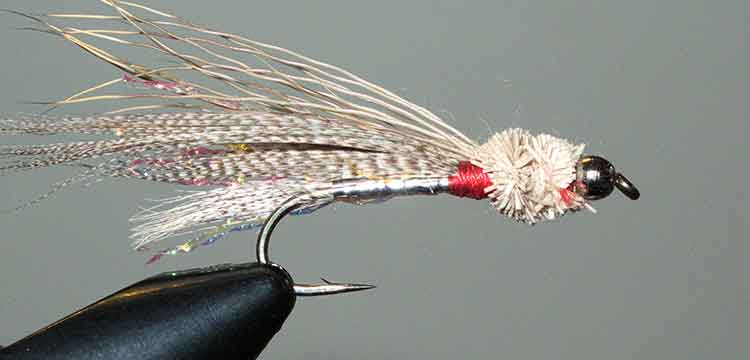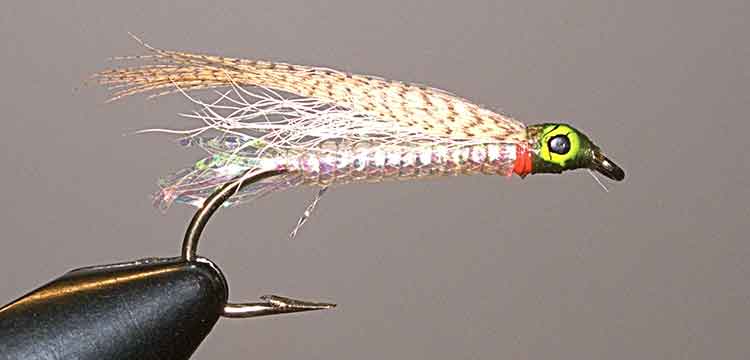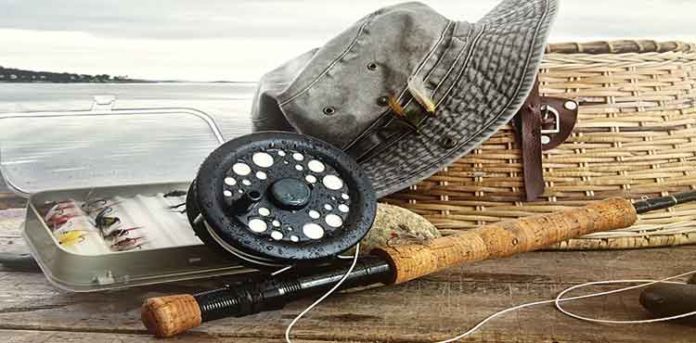Fly of the Month
By Bill Luscombe
Here on Vancouver Island we have ample opportunity to fish low-lying lakes and even the ocean estuaries and beaches in winter or early spring. Many of these lakes have natural or stocked populations of cutthroat trout.
Cutthroat trout are a great sportfish. They are aggressive, so much so that we often say that they are on a “seefood diet” … whatever they can see they eat. While not entirely true, I have fished for the proverbial “cutties” many times and am well aware that they turn piscivorous as they grow. Knowing this, I always ply cutthroat waters with minnow patterns, and the two patterns I show here are the ones I go to all the time.
The bead head muddler is a great cutthroat prospecting pattern that works on sea-run cutties as well as lake and river dwelling cutthroats.

The Bead Head Muddler Minnow
Materials
Thread: Red
Tail: Barred mallard flank
Body: Flat silver tinsel
Underwing: Crystal flash
Middle Wing: Barred mallard flank
Overwing: Deer hair
Hackle/throat: Red thread
Head: Deer hair, spun and clipped and silver bead
Tying Steps
- Slide on the silver bead head. Wrap thread back to the butt.
- Tie in a tail of barred mallard flank.
- Tie in a length of flat silver tinsel and wind forward to create the body. Make sure you leave enough bare hook at the head to tie in and spin the deer hair head.
- Tie in an underwing of crystal flash. The colour is your choice (I like holographic), tail length.
- Tie in the middle wing of barred mallard flank, tail length or a bit longer.
- Wrap some of the red thread as a collar.
- Tightly spin on deer hair for the head and overwing. Make sure the hair is long enough to be equal to the length of the middle wing.
- Clip the spun deer hair to make a hair head, being sure to leave a bit as an overwing on top.
- Whip finish.

The Stickleback Minnow
The stickleback minnow pattern is an awesome fly for cutthroat in tea-stained coastal lakes; it imitates the little stickleback minnows that inhabit these waters well. Fish the fly along the deep edges of weedbeds. The cutthroats take them aggressively, so be prepared for a hard strike.
Materials
Thread: Black
Tail: None
Body: Holographic mylar tubing
Rib: Monofilament line
Underwing: White bucktail
Overwing: Barred mallard flank
Hackle/Throat: Red thread or red hackle as gills
Head: Black thread with eyes. Epoxied.
Tying Steps
- Tie in the monofilament rib material at the butt of the hook.
- Slide the holographic tubing over the shank, being sure to leave a bit loose to for a short tail.
- Wrap the monofilament forward around the tubing to the head.
- Tie off the tubing and monofilament by tying in the red thread. Be sure to wrap the red thread back a little so some will show as gills. If you want to use red hackle then tie those in now and secure the hackle, monofilament, and tubing all at once.
- Tie in a somewhat sparse underwing of white bucktail and then an overwing of barred mallard flank.
- Form a black head by wrapping the black thread and then whip finish.
- You can either now epoxy the head and paint on eyes, stick on eyes and then epoxy the entire head, or simply leave the head without eyes and cement the head.






